Economic Principles: GDP, Unemployment, Inflation and Aggregate Demand
VerifiedAdded on 2023/06/07
|9
|1541
|178
AI Summary
This article discusses the economic principles of GDP, unemployment, inflation and aggregate demand. It covers topics such as intermediate goods, calculation of GDP, unemployment rate, consumer price index, and the effects of inflation on lenders, wealth, and net exports.
Contribute Materials
Your contribution can guide someone’s learning journey. Share your
documents today.

Running head: ECONOMIC PRINCIPLES 1
Economic principles
Name of the student:
Name of the University:
Authors Note:
Economic principles
Name of the student:
Name of the University:
Authors Note:
Secure Best Marks with AI Grader
Need help grading? Try our AI Grader for instant feedback on your assignments.
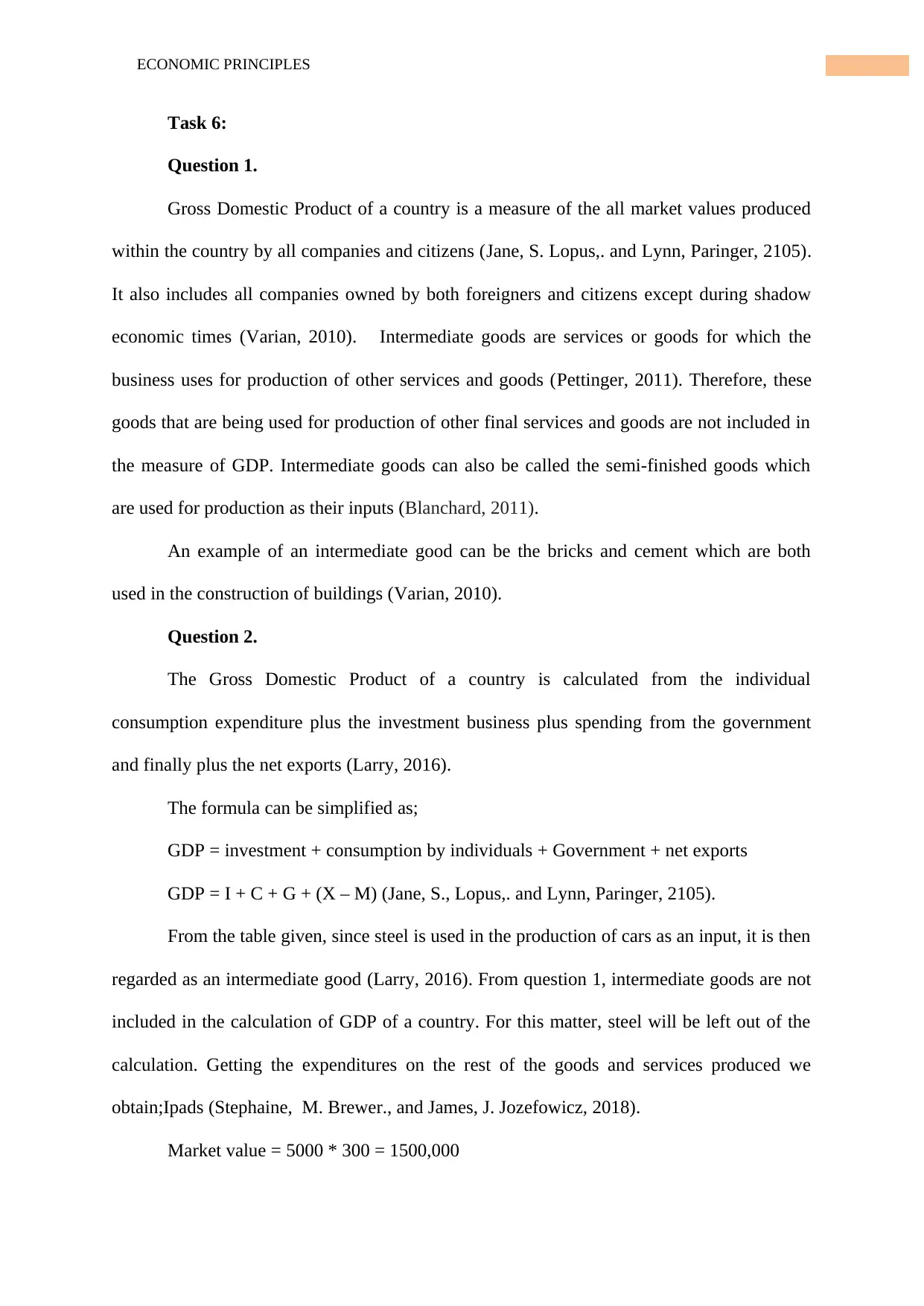
1ECONOMIC PRINCIPLES
Task 6:
Question 1.
Gross Domestic Product of a country is a measure of the all market values produced
within the country by all companies and citizens (Jane, S. Lopus,. and Lynn, Paringer, 2105).
It also includes all companies owned by both foreigners and citizens except during shadow
economic times (Varian, 2010). Intermediate goods are services or goods for which the
business uses for production of other services and goods (Pettinger, 2011). Therefore, these
goods that are being used for production of other final services and goods are not included in
the measure of GDP. Intermediate goods can also be called the semi-finished goods which
are used for production as their inputs (Blanchard, 2011).
An example of an intermediate good can be the bricks and cement which are both
used in the construction of buildings (Varian, 2010).
Question 2.
The Gross Domestic Product of a country is calculated from the individual
consumption expenditure plus the investment business plus spending from the government
and finally plus the net exports (Larry, 2016).
The formula can be simplified as;
GDP = investment + consumption by individuals + Government + net exports
GDP = I + C + G + (X – M) (Jane, S., Lopus,. and Lynn, Paringer, 2105).
From the table given, since steel is used in the production of cars as an input, it is then
regarded as an intermediate good (Larry, 2016). From question 1, intermediate goods are not
included in the calculation of GDP of a country. For this matter, steel will be left out of the
calculation. Getting the expenditures on the rest of the goods and services produced we
obtain;Ipads (Stephaine, M. Brewer., and James, J. Jozefowicz, 2018).
Market value = 5000 * 300 = 1500,000
Task 6:
Question 1.
Gross Domestic Product of a country is a measure of the all market values produced
within the country by all companies and citizens (Jane, S. Lopus,. and Lynn, Paringer, 2105).
It also includes all companies owned by both foreigners and citizens except during shadow
economic times (Varian, 2010). Intermediate goods are services or goods for which the
business uses for production of other services and goods (Pettinger, 2011). Therefore, these
goods that are being used for production of other final services and goods are not included in
the measure of GDP. Intermediate goods can also be called the semi-finished goods which
are used for production as their inputs (Blanchard, 2011).
An example of an intermediate good can be the bricks and cement which are both
used in the construction of buildings (Varian, 2010).
Question 2.
The Gross Domestic Product of a country is calculated from the individual
consumption expenditure plus the investment business plus spending from the government
and finally plus the net exports (Larry, 2016).
The formula can be simplified as;
GDP = investment + consumption by individuals + Government + net exports
GDP = I + C + G + (X – M) (Jane, S., Lopus,. and Lynn, Paringer, 2105).
From the table given, since steel is used in the production of cars as an input, it is then
regarded as an intermediate good (Larry, 2016). From question 1, intermediate goods are not
included in the calculation of GDP of a country. For this matter, steel will be left out of the
calculation. Getting the expenditures on the rest of the goods and services produced we
obtain;Ipads (Stephaine, M. Brewer., and James, J. Jozefowicz, 2018).
Market value = 5000 * 300 = 1500,000
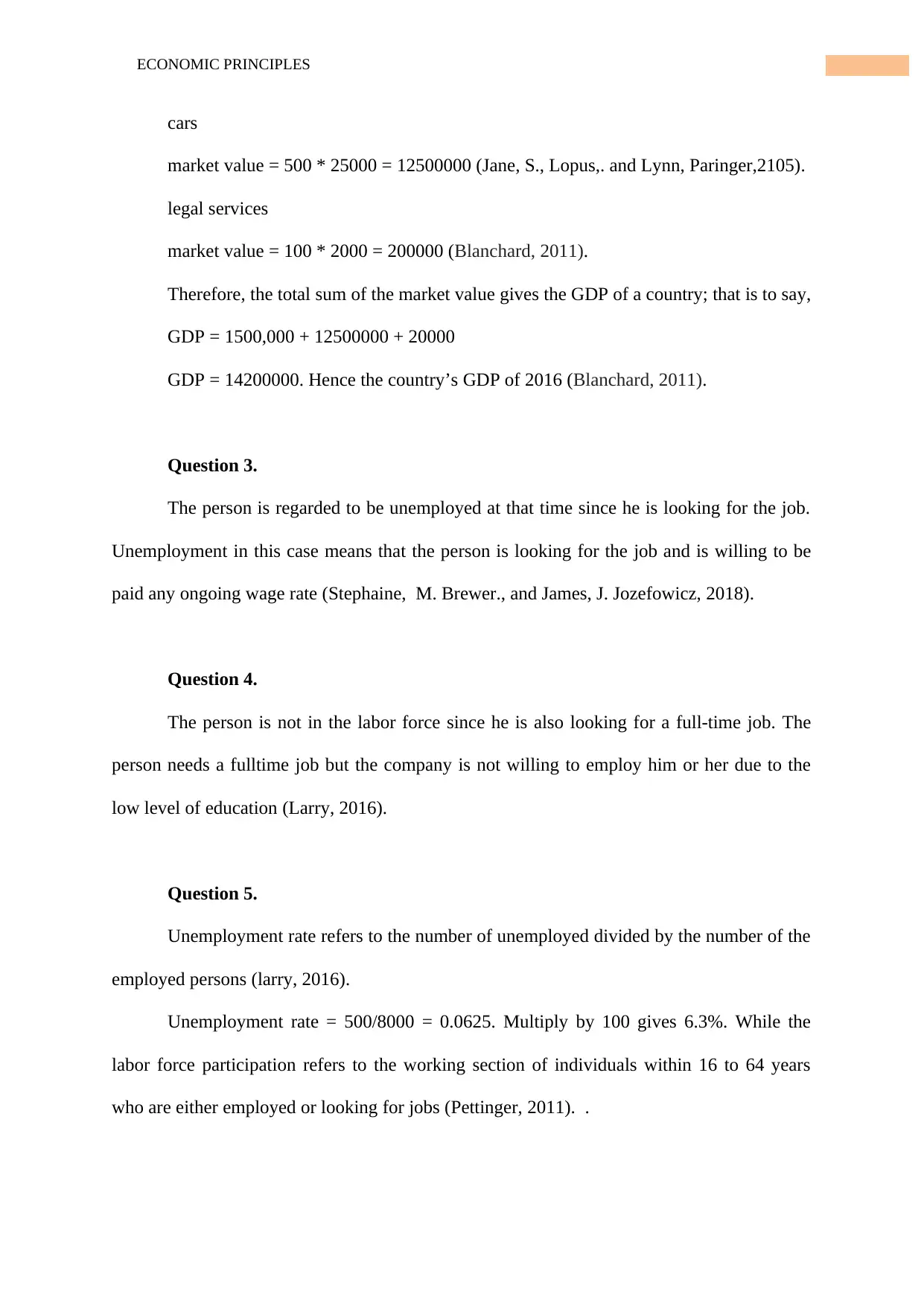
2ECONOMIC PRINCIPLES
cars
market value = 500 * 25000 = 12500000 (Jane, S., Lopus,. and Lynn, Paringer,2105).
legal services
market value = 100 * 2000 = 200000 (Blanchard, 2011).
Therefore, the total sum of the market value gives the GDP of a country; that is to say,
GDP = 1500,000 + 12500000 + 20000
GDP = 14200000. Hence the country’s GDP of 2016 (Blanchard, 2011).
Question 3.
The person is regarded to be unemployed at that time since he is looking for the job.
Unemployment in this case means that the person is looking for the job and is willing to be
paid any ongoing wage rate (Stephaine, M. Brewer., and James, J. Jozefowicz, 2018).
Question 4.
The person is not in the labor force since he is also looking for a full-time job. The
person needs a fulltime job but the company is not willing to employ him or her due to the
low level of education (Larry, 2016).
Question 5.
Unemployment rate refers to the number of unemployed divided by the number of the
employed persons (larry, 2016).
Unemployment rate = 500/8000 = 0.0625. Multiply by 100 gives 6.3%. While the
labor force participation refers to the working section of individuals within 16 to 64 years
who are either employed or looking for jobs (Pettinger, 2011). .
cars
market value = 500 * 25000 = 12500000 (Jane, S., Lopus,. and Lynn, Paringer,2105).
legal services
market value = 100 * 2000 = 200000 (Blanchard, 2011).
Therefore, the total sum of the market value gives the GDP of a country; that is to say,
GDP = 1500,000 + 12500000 + 20000
GDP = 14200000. Hence the country’s GDP of 2016 (Blanchard, 2011).
Question 3.
The person is regarded to be unemployed at that time since he is looking for the job.
Unemployment in this case means that the person is looking for the job and is willing to be
paid any ongoing wage rate (Stephaine, M. Brewer., and James, J. Jozefowicz, 2018).
Question 4.
The person is not in the labor force since he is also looking for a full-time job. The
person needs a fulltime job but the company is not willing to employ him or her due to the
low level of education (Larry, 2016).
Question 5.
Unemployment rate refers to the number of unemployed divided by the number of the
employed persons (larry, 2016).
Unemployment rate = 500/8000 = 0.0625. Multiply by 100 gives 6.3%. While the
labor force participation refers to the working section of individuals within 16 to 64 years
who are either employed or looking for jobs (Pettinger, 2011). .
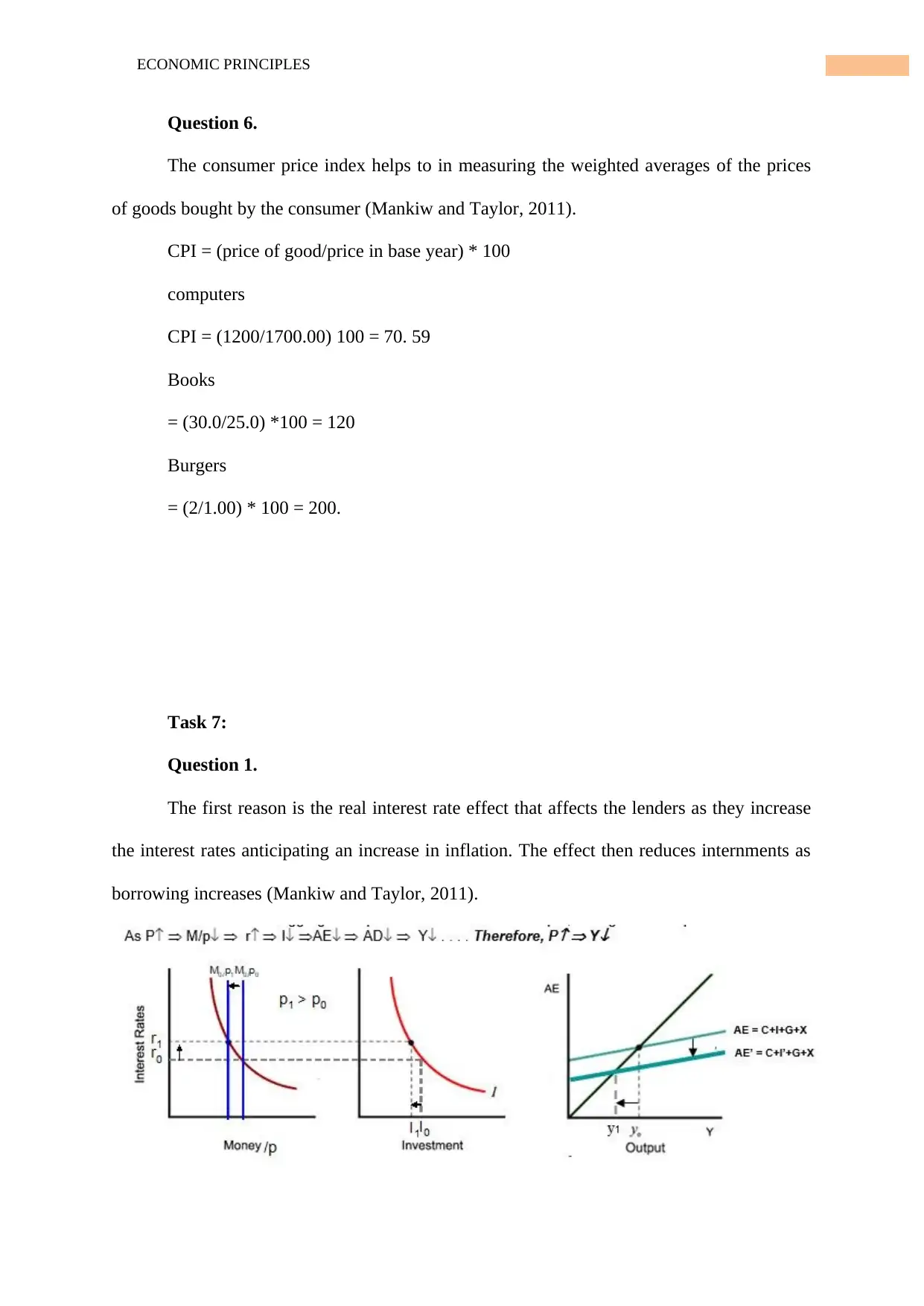
3ECONOMIC PRINCIPLES
Question 6.
The consumer price index helps to in measuring the weighted averages of the prices
of goods bought by the consumer (Mankiw and Taylor, 2011).
CPI = (price of good/price in base year) * 100
computers
CPI = (1200/1700.00) 100 = 70. 59
Books
= (30.0/25.0) *100 = 120
Burgers
= (2/1.00) * 100 = 200.
Task 7:
Question 1.
The first reason is the real interest rate effect that affects the lenders as they increase
the interest rates anticipating an increase in inflation. The effect then reduces internments as
borrowing increases (Mankiw and Taylor, 2011).
Question 6.
The consumer price index helps to in measuring the weighted averages of the prices
of goods bought by the consumer (Mankiw and Taylor, 2011).
CPI = (price of good/price in base year) * 100
computers
CPI = (1200/1700.00) 100 = 70. 59
Books
= (30.0/25.0) *100 = 120
Burgers
= (2/1.00) * 100 = 200.
Task 7:
Question 1.
The first reason is the real interest rate effect that affects the lenders as they increase
the interest rates anticipating an increase in inflation. The effect then reduces internments as
borrowing increases (Mankiw and Taylor, 2011).
Secure Best Marks with AI Grader
Need help grading? Try our AI Grader for instant feedback on your assignments.
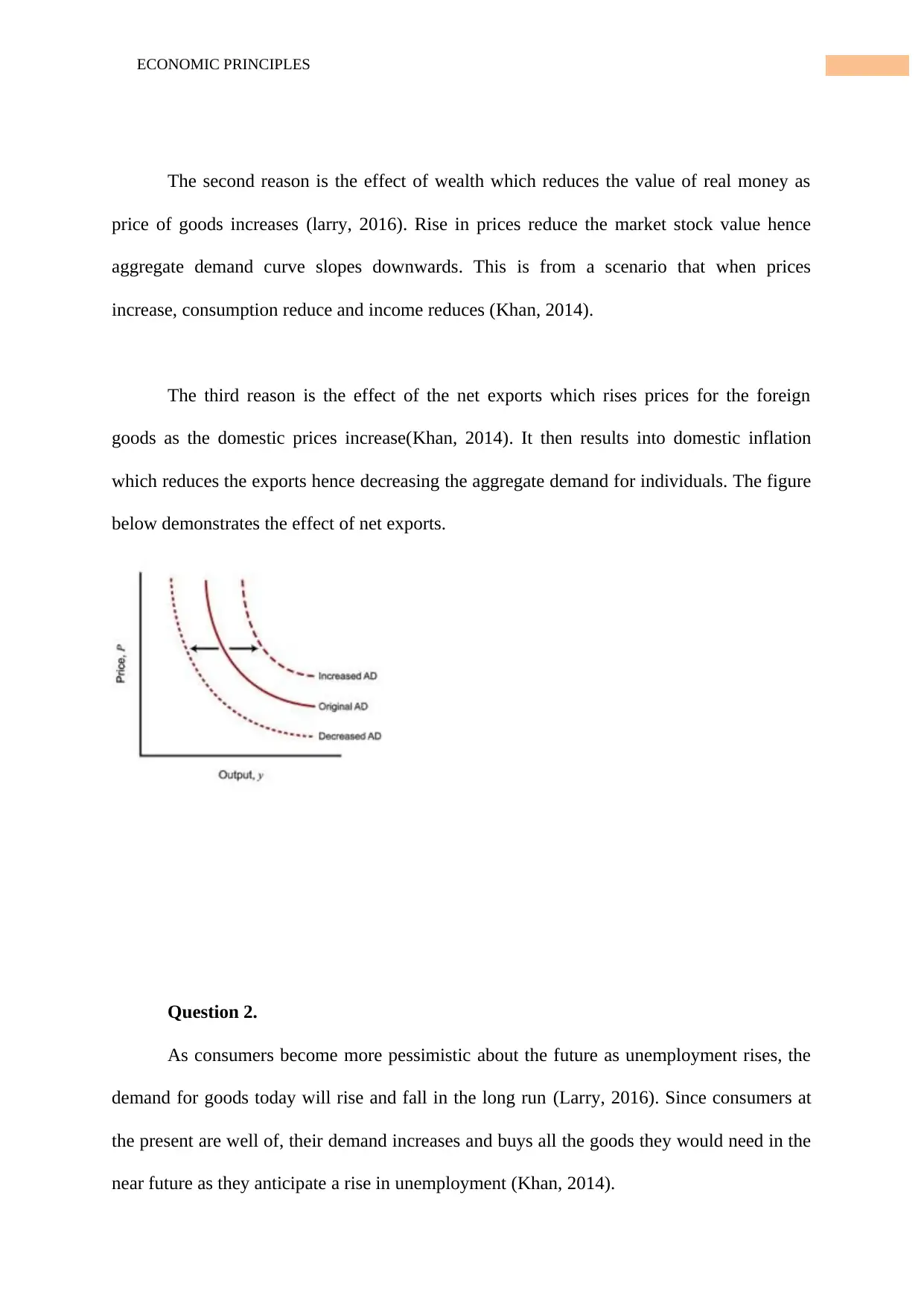
4ECONOMIC PRINCIPLES
The second reason is the effect of wealth which reduces the value of real money as
price of goods increases (larry, 2016). Rise in prices reduce the market stock value hence
aggregate demand curve slopes downwards. This is from a scenario that when prices
increase, consumption reduce and income reduces (Khan, 2014).
The third reason is the effect of the net exports which rises prices for the foreign
goods as the domestic prices increase(Khan, 2014). It then results into domestic inflation
which reduces the exports hence decreasing the aggregate demand for individuals. The figure
below demonstrates the effect of net exports.
Question 2.
As consumers become more pessimistic about the future as unemployment rises, the
demand for goods today will rise and fall in the long run (Larry, 2016). Since consumers at
the present are well of, their demand increases and buys all the goods they would need in the
near future as they anticipate a rise in unemployment (Khan, 2014).
The second reason is the effect of wealth which reduces the value of real money as
price of goods increases (larry, 2016). Rise in prices reduce the market stock value hence
aggregate demand curve slopes downwards. This is from a scenario that when prices
increase, consumption reduce and income reduces (Khan, 2014).
The third reason is the effect of the net exports which rises prices for the foreign
goods as the domestic prices increase(Khan, 2014). It then results into domestic inflation
which reduces the exports hence decreasing the aggregate demand for individuals. The figure
below demonstrates the effect of net exports.
Question 2.
As consumers become more pessimistic about the future as unemployment rises, the
demand for goods today will rise and fall in the long run (Larry, 2016). Since consumers at
the present are well of, their demand increases and buys all the goods they would need in the
near future as they anticipate a rise in unemployment (Khan, 2014).
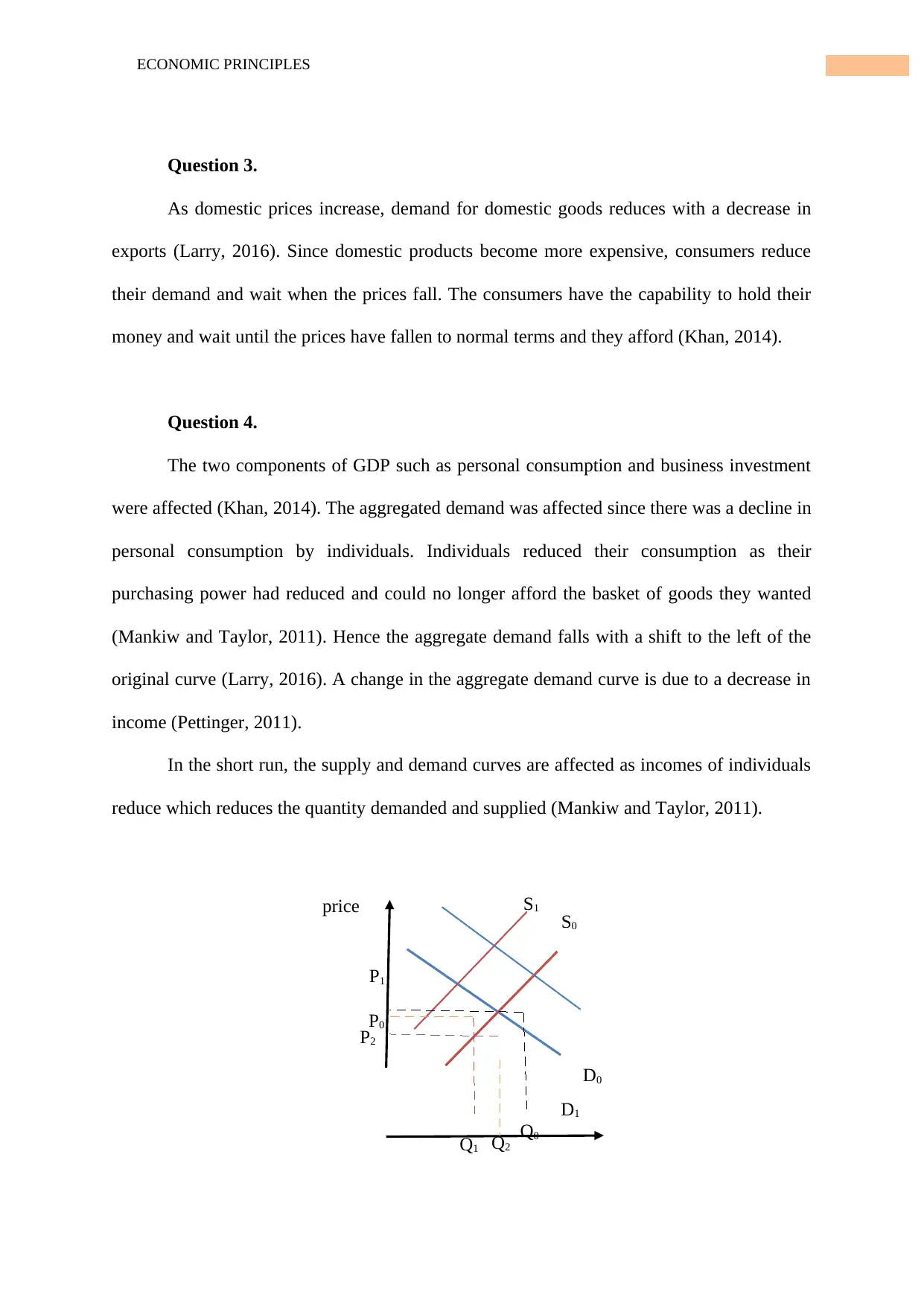
5ECONOMIC PRINCIPLES
Question 3.
As domestic prices increase, demand for domestic goods reduces with a decrease in
exports (Larry, 2016). Since domestic products become more expensive, consumers reduce
their demand and wait when the prices fall. The consumers have the capability to hold their
money and wait until the prices have fallen to normal terms and they afford (Khan, 2014).
Question 4.
The two components of GDP such as personal consumption and business investment
were affected (Khan, 2014). The aggregated demand was affected since there was a decline in
personal consumption by individuals. Individuals reduced their consumption as their
purchasing power had reduced and could no longer afford the basket of goods they wanted
(Mankiw and Taylor, 2011). Hence the aggregate demand falls with a shift to the left of the
original curve (Larry, 2016). A change in the aggregate demand curve is due to a decrease in
income (Pettinger, 2011).
In the short run, the supply and demand curves are affected as incomes of individuals
reduce which reduces the quantity demanded and supplied (Mankiw and Taylor, 2011).
price
P0
P1
Q0
P2
Q1 Q2
S1
S0
D0
D1
Question 3.
As domestic prices increase, demand for domestic goods reduces with a decrease in
exports (Larry, 2016). Since domestic products become more expensive, consumers reduce
their demand and wait when the prices fall. The consumers have the capability to hold their
money and wait until the prices have fallen to normal terms and they afford (Khan, 2014).
Question 4.
The two components of GDP such as personal consumption and business investment
were affected (Khan, 2014). The aggregated demand was affected since there was a decline in
personal consumption by individuals. Individuals reduced their consumption as their
purchasing power had reduced and could no longer afford the basket of goods they wanted
(Mankiw and Taylor, 2011). Hence the aggregate demand falls with a shift to the left of the
original curve (Larry, 2016). A change in the aggregate demand curve is due to a decrease in
income (Pettinger, 2011).
In the short run, the supply and demand curves are affected as incomes of individuals
reduce which reduces the quantity demanded and supplied (Mankiw and Taylor, 2011).
price
P0
P1
Q0
P2
Q1 Q2
S1
S0
D0
D1
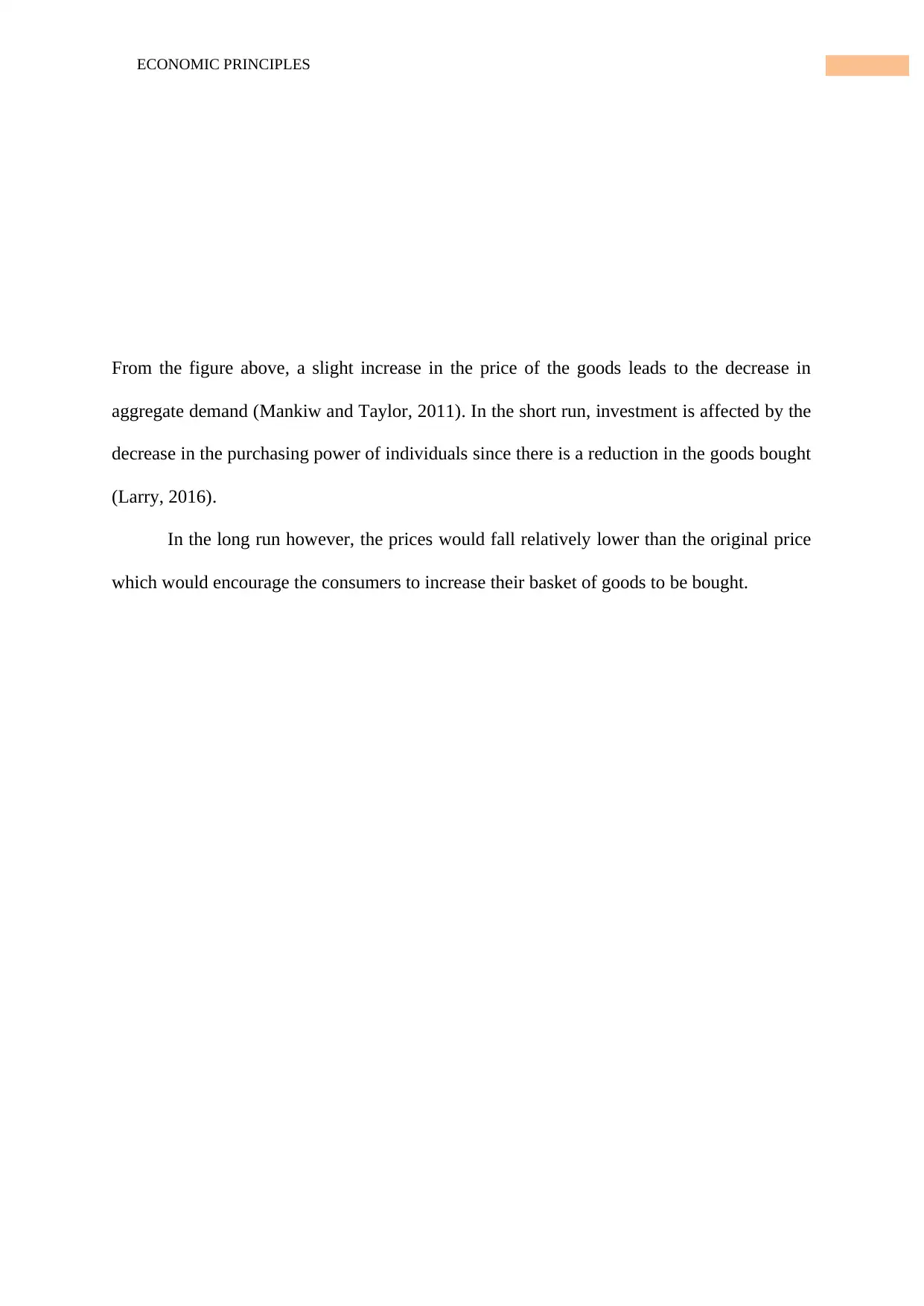
6ECONOMIC PRINCIPLES
From the figure above, a slight increase in the price of the goods leads to the decrease in
aggregate demand (Mankiw and Taylor, 2011). In the short run, investment is affected by the
decrease in the purchasing power of individuals since there is a reduction in the goods bought
(Larry, 2016).
In the long run however, the prices would fall relatively lower than the original price
which would encourage the consumers to increase their basket of goods to be bought.
From the figure above, a slight increase in the price of the goods leads to the decrease in
aggregate demand (Mankiw and Taylor, 2011). In the short run, investment is affected by the
decrease in the purchasing power of individuals since there is a reduction in the goods bought
(Larry, 2016).
In the long run however, the prices would fall relatively lower than the original price
which would encourage the consumers to increase their basket of goods to be bought.
Paraphrase This Document
Need a fresh take? Get an instant paraphrase of this document with our AI Paraphraser
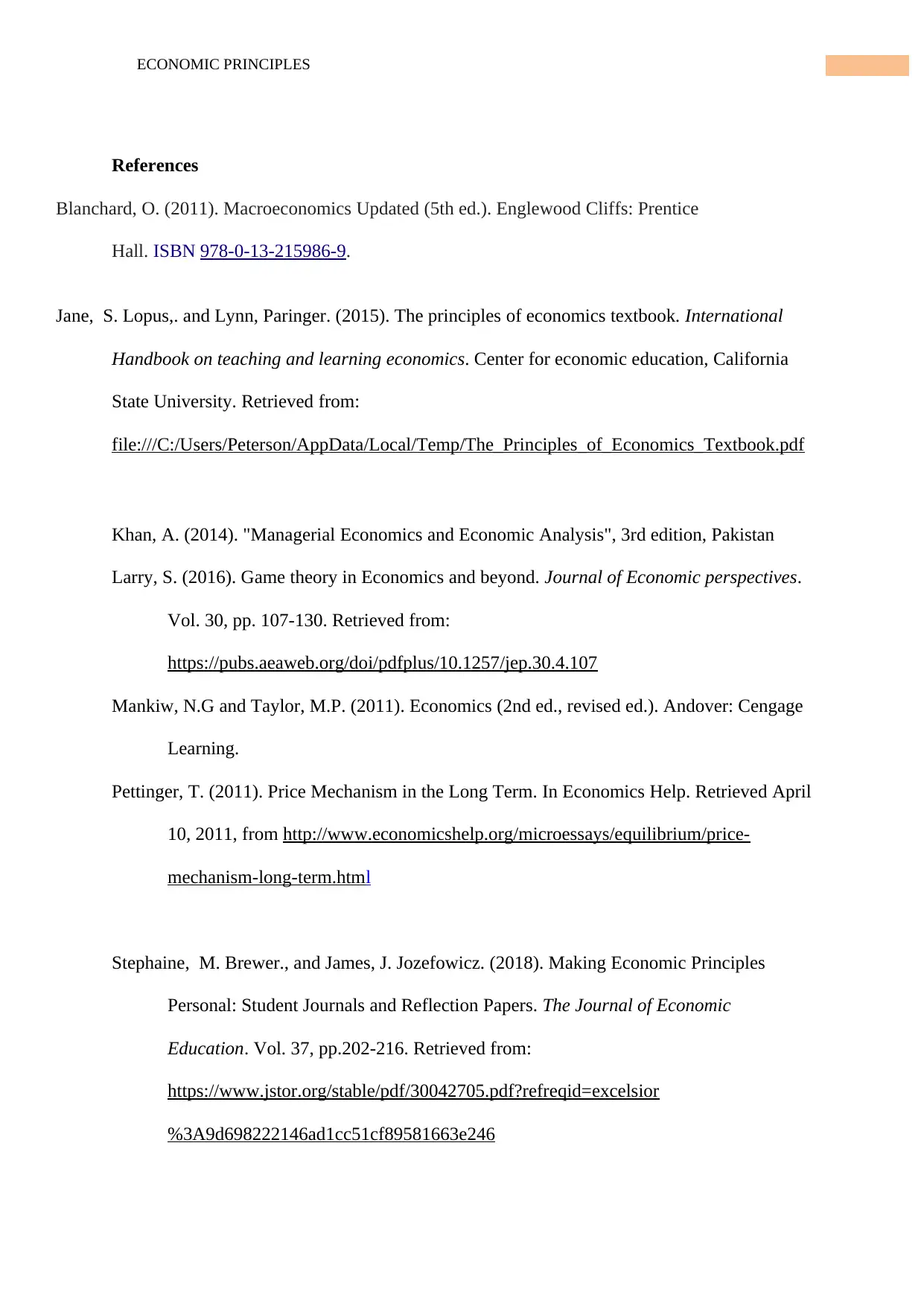
7ECONOMIC PRINCIPLES
References
Blanchard, O. (2011). Macroeconomics Updated (5th ed.). Englewood Cliffs: Prentice
Hall. ISBN 978-0-13-215986-9.
Jane, S. Lopus,. and Lynn, Paringer. (2015). The principles of economics textbook. International
Handbook on teaching and learning economics. Center for economic education, California
State University. Retrieved from:
file:///C:/Users/Peterson/AppData/Local/Temp/The_Principles_of_Economics_Textbook.pdf
Khan, A. (2014). "Managerial Economics and Economic Analysis", 3rd edition, Pakistan
Larry, S. (2016). Game theory in Economics and beyond. Journal of Economic perspectives.
Vol. 30, pp. 107-130. Retrieved from:
https://pubs.aeaweb.org/doi/pdfplus/10.1257/jep.30.4.107
Mankiw, N.G and Taylor, M.P. (2011). Economics (2nd ed., revised ed.). Andover: Cengage
Learning.
Pettinger, T. (2011). Price Mechanism in the Long Term. In Economics Help. Retrieved April
10, 2011, from http://www.economicshelp.org/microessays/equilibrium/price-
mechanism-long-term.html
Stephaine, M. Brewer., and James, J. Jozefowicz. (2018). Making Economic Principles
Personal: Student Journals and Reflection Papers. The Journal of Economic
Education. Vol. 37, pp.202-216. Retrieved from:
https://www.jstor.org/stable/pdf/30042705.pdf?refreqid=excelsior
%3A9d698222146ad1cc51cf89581663e246
References
Blanchard, O. (2011). Macroeconomics Updated (5th ed.). Englewood Cliffs: Prentice
Hall. ISBN 978-0-13-215986-9.
Jane, S. Lopus,. and Lynn, Paringer. (2015). The principles of economics textbook. International
Handbook on teaching and learning economics. Center for economic education, California
State University. Retrieved from:
file:///C:/Users/Peterson/AppData/Local/Temp/The_Principles_of_Economics_Textbook.pdf
Khan, A. (2014). "Managerial Economics and Economic Analysis", 3rd edition, Pakistan
Larry, S. (2016). Game theory in Economics and beyond. Journal of Economic perspectives.
Vol. 30, pp. 107-130. Retrieved from:
https://pubs.aeaweb.org/doi/pdfplus/10.1257/jep.30.4.107
Mankiw, N.G and Taylor, M.P. (2011). Economics (2nd ed., revised ed.). Andover: Cengage
Learning.
Pettinger, T. (2011). Price Mechanism in the Long Term. In Economics Help. Retrieved April
10, 2011, from http://www.economicshelp.org/microessays/equilibrium/price-
mechanism-long-term.html
Stephaine, M. Brewer., and James, J. Jozefowicz. (2018). Making Economic Principles
Personal: Student Journals and Reflection Papers. The Journal of Economic
Education. Vol. 37, pp.202-216. Retrieved from:
https://www.jstor.org/stable/pdf/30042705.pdf?refreqid=excelsior
%3A9d698222146ad1cc51cf89581663e246

8ECONOMIC PRINCIPLES
Varian, H.R. (2010). Intermediate microeconomics: a modern approach. New York, NY:
W.W. Norton & Co.
Varian, H.R. (2010). Intermediate microeconomics: a modern approach. New York, NY:
W.W. Norton & Co.
1 out of 9
Your All-in-One AI-Powered Toolkit for Academic Success.
+13062052269
info@desklib.com
Available 24*7 on WhatsApp / Email
![[object Object]](/_next/static/media/star-bottom.7253800d.svg)
Unlock your academic potential
© 2024 | Zucol Services PVT LTD | All rights reserved.